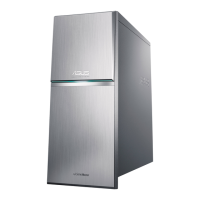
Do you have a question about the Asus M70AD and is the answer not in the manual?
| Tcase | 71.35 °C |
|---|---|
| Bus type | QPI |
| Stepping | C0 |
| Processor cache | 6 MB |
| Processor cores | 4 |
| Processor model | i5-4440S |
| System bus rate | 5 GT/s |
| Processor family | Intel® Core™ i5 |
| Processor series | Intel Core i5-4400 Desktop series |
| Processor socket | LGA 1150 (Socket H3) |
| Processor codename | Haswell |
| Processor frequency | 2.8 GHz |
| Processor cache type | Smart Cache |
| Processor lithography | 22 nm |
| Processor manufacturer | Intel |
| Processor front side bus | - MHz |
| PCI Express slots version | 3.0 |
| Processor boost frequency | 3.3 GHz |
| Processor operating modes | 64-bit |
| ECC supported by processor | No |
| PCI Express configurations | 1x16, 2x8, 1x8+2x4 |
| Thermal Design Power (TDP) | 65 W |
| Number of processors installed | 1 |
| Maximum number of PCI Express lanes | 16 |
| Memory types supported by processor | DDR3-SDRAM |
| Memory clock speeds supported by processor | 1333, 1600 MHz |
| Memory bandwidth supported by processor (max) | 25.6 GB/s |
| Maximum internal memory supported by processor | 32 GB |
| Memory slots | 2x DIMM |
| Internal memory | 4 GB |
| Memory channels | Dual-channel |
| Memory clock speed | 1600 MHz |
| Maximum internal memory | 16 GB |
| Memory layout (slots x size) | - GB |
| HDD speed | 7200 RPM |
| HDD interface | SATA III |
| Storage media | HDD |
| Optical drive type | DVD Super Multi |
| Card reader integrated | Yes |
| Total storage capacity | 1000 GB |
| Compatible memory cards | CF, Memory Stick (MS), MicroDrive, MicroSD (TransFlash), MiniSD, MMC, MS Duo, MS Micro (M2), MS PRO, MS PRO Duo, RS-MMC, SD, SDHC |
| Intel® Virtualization Technology (Intel® VT) | VT-d, VT-x |
| On-board graphics card ID | 0x412 |
| Discrete graphics card model | NVIDIA® GeForce® GT 620 |
| On-board graphics card model | Intel® HD Graphics 4600 |
| Discrete graphics card memory | 1024 GB |
| On-board graphics card family | Intel® HD Graphics |
| Maximum on-board graphics card memory | 1.74 GB |
| On-board graphics card base frequency | 350 MHz |
| On-board graphics card DirectX version | 11.1 |
| On-board graphics card dynamic frequency (max) | 1100 MHz |
| Number of displays supported (on-board graphics) | 3 |
| Operating system installed | FreeDOS |
| Operating system architecture | - |
| Cabling technology | 10/100/1000Base-T(X) |
| Ethernet LAN data rates | 10, 100, 1000 Mbit/s |
| USB 2.0 ports quantity | 6 |
| USB 3.2 Gen 1 (3.1 Gen 1) Type-A ports quantity | 2 |
| Chassis type | Desktop |
| Product color | Stainless steel |
| Product type | PC |
| Motherboard chipset | Intel® H81 |
| Scalability | 1S |
| Processor ARK ID | 75040 |
| Processor package size | 37.5 x 37.5 mm |
| Supported instruction sets | AVX 2.0 |
| Thermal solution specification | PCG 2013C |
| Intel Identity Protection Technology version | 1.00 |
| Intel Stable Image Platform Program (SIPP) version | 0.00 |
| Power supply | 300 W |
| Depth | 412 mm |
|---|---|
| Width | 175 mm |
| Height | 433 mm |
| Weight | 9800 g |
| Package depth | 550 mm |
| Package width | 242 mm |
| Package height | 510 mm |
Identifies and explains the front and rear panels of the PC.
Guides on connecting monitors, peripherals, and power cords.
Instructions for turning on the computer.
Guides through the first-time setup and configuration of Windows 8.
Explains the Windows 8 User Interface, Start screen, and apps.
Lists useful keyboard shortcuts for efficient navigation.
Instructions for turning off or putting the computer to sleep.
Guide to access and configure system BIOS settings.
Guides through the first-time setup and configuration of Windows 8.1.
Explains the Windows 8.1 User Interface, Start screen, and apps.
Lists useful keyboard shortcuts for efficient navigation.
Instructions for turning off or putting the computer to sleep.
Guide to access and configure system BIOS settings.
How to connect and safely remove USB storage devices.
Connects headphones, microphones, and speaker systems.
Guides on setting up and using multiple monitors.
How to connect a High Definition TV to the computer.
Provides tips for maintaining correct posture while using the PC.
Instructions for using the built-in memory card reader.
How to insert and remove discs from the optical drive.
Steps for connecting to the internet via a wired network.
Steps to configure dynamic IP, PPPoE, or static IP internet connections.
Overview of ASUS AI Suite II and its integrated utilities.
Guides on updating motherboard BIOS and boot logo.
Guides on system recovery, PC reset, and creating recovery drives.
Addresses problems with powering on, system hangs, and keyboard input.
Troubleshoots wireless/LAN connectivity, monitor display, and HDTV picture issues.
Resolves problems with speakers, headphones, USB devices, and optical drives.
Solves issues related to system speed, ventilation, and CPU/fan noise.
Contact details for ASUS technical support across different regions.